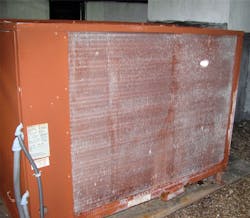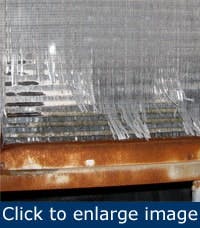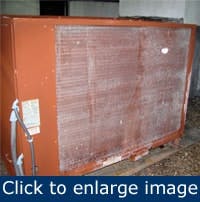HVAC/R refrigeration coils are leaking at an alarming rate in industrial, commercial and residential applications. While the reasons are many, chemicals ranging from household cleaners to industrial process compounds are the main culprits that produce leaks and pitting corrosion on all types of coils.
Figure 1. Continuous contact with contaminated condensate caused this corrosion.
Many HVAC manufacturers, distributors and contractors might not realize that corrosion caused hundreds of thousands of coil failures during the past decade. The source is typical environmental pollutants, which range from salt air, to household cleaning agents, pesticides, formaldehydes, building materials and even off-gassing of food. Each of these contamination sources can corrode coil tubing in a year or less, if the conditions are right (Figure 1).
For example, refrigeration coils in a South American fruit processing plant’s banana room were continually failing. The chamber used ethylene gas to ripen the fruit. Gaseous byproducts from the catalytic gas generator combined with the moisture in the ripening area to form a weak acid that produced pinhole leaks in the coil tubing after a year or less.
Aside from fruit-processing plants, most coastal area HVAC equipment is bombarded with corrosion caused by ocean salt (Figure 2).
Types of coil corrosion
Figure 2. This corroded coil is from a coastal area.
The most common forms of coil corrosion are pitting and formicary corrosion. Both can occur in as little as a few weeks after installation. More typically, corrosion begins appearing within a one-to-four-year period. The ability to distinguish pitting from formicary corrosion might help detect and eliminate the cause.
Pitting corrosion (Figure 3) is typically caused by the presence of chlorides or fluorides. Chlorides are found in numerous items such as snow-melting crystals, toilet bowl/tile cleaners, dishwasher detergents, fabric softeners, vinyl fabrics, carpeting and paint strippers. Fluorides are used in municipal water treatment. Pitting usually is visible on the exterior of a copper tube, visible to the naked eye. It’s caused by aggressive attack by chloride/fluoride ions that condensate carries to the metal surface. The cations attack the oxide film the metal uses to protect itself, essentially forming a corrosion-driven battery that consumes the copper. Once pits form in the copper tube, they progress through the tube wall forming a pinhole that leaks refrigerant.
Figure 3. This cross-section shows the results of pitting corrosion.
Formicary corrosion (Figure 4), on the other hand, is caused by organic acids such as acetic and formic acids. Acetic acids are abundant in numerous household products such as adhesives, paneling, particle board, silicone caulking, cleaning solvents, vinegar, foam insulation and dozens of other commonly used products. Formic acid can be found in cosmetics, disinfectants, tobacco and wood smoke, latex paints, plywood and dozens of other materials. The corrosion these substances cause usually isn’t visible to the naked eye, although black or blue-gray deposits sometimes can be seen on the surface. Formicary corrosion produces a subsurface network of microscopic tunnels within the tubing wall. It resembles ant nest-type structures that are substantially larger than the surface pinholes. Eventually, one or more of these tunnels progresses to the surface of the copper and form a pinhole, which quickly results in coil leakage.
Choosing the right coating
Figure 4. This cross-section shows how deep-seated formicary corrosion can penetrate a copper tube
The first step to take when confronted with coil corrosion is to determine if it will happen again after coil replacement. It’s difficult to determine if the corrosion is a one-time phenomenon or a continuing problem in that geographic location. In the case of the banana processing plant or a coastal area unit, coils most likely will continually corrode, and their replacement units should have a protective coating.
In less corrosive environments, you can attempt to prevent corrosive materials, such as cleaning solvents, from entering the return air stream. Perhaps these materials can be stored in areas far from a return duct. This might eliminate the expense and need to coat a replacement unit.
Choosing the most appropriate coil coating for the application could save thousands of dollars and eliminate repeat treatments. Choosing the wrong coil coating could degrade heat transfer and lead to higher energy bills.
{pb}Heat transfer is a major concern when coating a coil, especially in a retrofit application, because the coil might no longer perform at its design specification. The thinner the coating, the better the heat transfer; a thick coating can significantly diminish heat transfer. Another concern is the coating’s hydrophobicity, or how well condensation drains off the coil. Ideally, water would drain off of the coil quickly to avoid efficiency reductions. Surface water accumulation is detrimental because it can lead to the growth of mold and mildew. Most coatings don’t actively resist biological growth, but high hydrophobicity can passively deter such growth.
The choices
The four most prominent coating types for the HVAC industry are polyurethanes, epoxies, fluoropolymers and silanes. Each coating offers differing advantages in terms of corrosion resistance, scratch resistance, flexibility, weight, thickness, hydrophobicity and heat transfer capabilities.
Polyurethane (PU), invented in the 1940s, is used in a variety of applications. It can be manufactured as hard as fiberglass, bouncy as rubber, sticky as glue and soft as upholstery foam. Many off-the-shelf PU-based coil coatings can be applied in the field. PU formulations are fairly inexpensive, less viscous, more flexible and thinner — typically 25 microns to 50 microns — than most coatings. The disadvantage is they aren’t as resilient or long-lasting as other coatings.
[pullquote]Epoxy, or phenolic-based, coatings generally are fairly inexpensive. Epoxies, developed in the late 1920s, are known for excellent chemical and heat resistance and often are used for coating floors and other surfaces. The high viscosity of epoxy-based systems leads to thicker coatings — approximately 50 microns to 100 microns — with poor flexibility and long term adherence. An epoxy coating is difficult to apply in the field. Typically, the coil is disconnected and shipped to a contractor or OEM for a professional treatment. Because they’re thicker, epoxy coatings reduce heat transfer and thus decrease system efficiency and capacity. Epoxy coatings might best suit new installations where heat transfer losses are accounted for in the system design specifications.
Fluoropolymers, first developed in 1938 by DuPont under the trade name Teflon, are now available in many forms under a variety of trade names. Fluoropolymers are known for their high resistance to acids, solvents and bases. They’re most effectively applied to metal through electrostatic powder coating or by a thermal sintering process, as is done during the manufacturing of cookware and other non-stick products.
Additionally, many field-applied fluoropolymer sprays are available to contractors. These sprays generally have very poor adhesion, and their effectiveness diminishes significantly in a short time. The cost of fluoropolymer-based field-use coatings is typically less than the more advanced epoxy- and PU-based coating systems, but the lifetime and effectiveness is limited. Fluoropolymer coatings applied in the correct manner, through thermal sintering or electrocoating, haven’t gained traction in the HVAC industry because of the expense and their inability to be performed in the field.
Silanes are well-known as excellent coupling agents that can bond dissimilar materials such as paint (an organic material) and glass (an inorganic material). A variety of silane chemistries are available, many of which are tailored to have particular characteristics such as flexibility, hydrophobicity and scratch-resistance. Thus, a properly formulated silane coating can provide a flexible, resilient, glass-like coating with good corrosion resistance and water-draining capability, that bonds well to aluminum and copper (an inorganic material). Silanes form an extremely thin coating — less than 10 microns — when cured, that has little, if any, adverse effects on heat transfer. Silanes can be formulated to be resilient to cracking and corrosion, are hydrophobic. Silanes can be difficult to apply properly in the field if you’re not a trained applicator. The coil surfaces must be cleaned thoroughly and prepared properly for a successful application and, therefore, it’s best if the coating is applied off-site. Although silane coatings typically are somewhat more expensive than the other coatings, they also exhibit the best heat transfer properties and typically have a much greater lifetime as well.
Our research indicates that a silane-based coating provides the best protection from the environment and has minimal effect on heat transfer while remaining a long-lasting barrier that protects an HVAC coil against corrosion for an extended time – typically five years or more.
Each coating technology carries different levels of toxicity. Service technicians planning to apply any of these coatings in the field should be outfitted with proper OSHA equipment and the appropriate breathing apparatus.
Joshua D. Sole, Ph.D., is a Sr. Mechanical Engineer and Alan H. Brothers, Ph.D., is a former Sr. Materials Engineer at Mainstream Engineering Corp., Rockledge, Fla. Contact Josh at [email protected] and (321) 631-3550.




